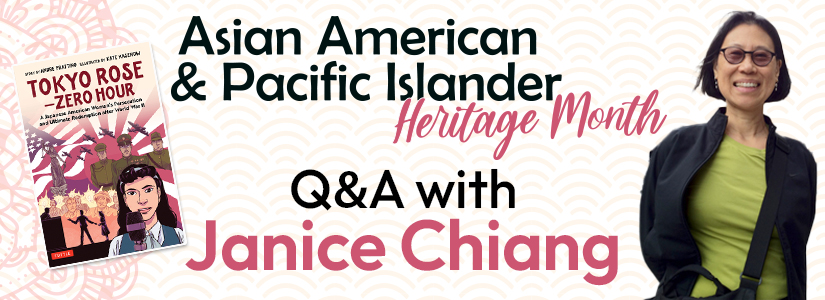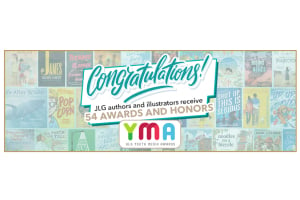Q&A with Janice Chiang



To honor literature that is representative of Asian American and Pacific Islander Heritage Month, we chatted with Digital Artist, Janice Chiang about her recent project, Tokyo Rose: Zero Hour. Tokyo Rose: Zero Hour is a graphic novel written by Andre Fratting and illustrated by Kate Kasenow. This book tells the story of Iva Toguri, a Japanese American citizen who became stuck in Japan during the attack on Pearl Harbor. She takes a job at Radio Tokyo where she is required to host “Zero Hour,” a radio show meant to bring down morale of American troops. You’ll have to read the story to find out how she turned that assignment around...
Q: Tell us a little about your lettering role for Tokyo Rose: Zero Hour
A: When I started the lettering for Tokyo Rose: Zero Hour, I had to make sure that the letters created an experience on the page; the reader reads the story, then looks at the art, then scans the page again... you must coordinate it all very well. Basically, I take a 2D world created by the writer and artist, and I describe it in a 3D way. This is achieved by the placement and design of balloons (types of fonts used for the speakers) and sound effects (with their onomatopoeia) which create “the silent soundtrack,” as Stan Lee described comic lettering. It wasn’t until Manga translation books came to the United States that it became more accepted for stories to be written in a graphic novel length and format, although graphic novels in Japan go back to the 1600’s!
Q: When did you first become aware of the story of Tokyo Rose and Iva Toguri?
A: I was born during the Cold War Years—this is where I must stop and thank the public libraries—and my family and I read religiously from books that we took out of the library to learn the English language and to assimilate to English culture. That practice continues to be as important today as it was back then; there are many students from other countries that need services and materials from public libraries to help them become a part of a new country.
I studied American History in school, and there was very little curriculum about the struggles of immigrant populations, however, my parents didn’t want me to make waves. It was difficult to find alternative histories, but I found what I could. When I searched for Asian American History, I couldn’t find many books.
The War in Vietnam sparked a rise in college students organizing protests. At the same time, the struggle began for recognition of Asian American History as a legitimate field of study for academic accreditation. Today, at NYU, someone can get a PhD from the Asian Pacific American department. My eldest sister, Fay Chiang, was very active in the political movement during the 1960’s and 1970’s and helped to organize the Chinatown community in the lower east side of New York City.
Many of our friends are still active in achieving great things. My two sisters and I attended Hunter College and began a Chinese American group that became an Asian American organization where we helped organize events. One of the leaders that spoke at one of our events was Mary Kochimaya, an American civil rights activist. She was the person who held Malcom X in her arms as he lay dying after being shot in New York City in 1965. Mary’s family had been in the internment camps. They were searching everywhere for their history, and so was I. That’s how I discovered the story of Iva Toguri.
Q: What can we all learn from Iva?
A: Iva has a strong faith; she believes in herself and that all people are generally good. She found friends wherever she was, and those were the people who came back to defend her when she went to trial. Throughout the story, Iva realized that she wasn’t alone, that people loved and cared for her. She reminds us that there is always someone out there who will be kind to you, who can teach you something, or can help you. In turn, you can help others when you see an unjust situation—do something or speak out. We are never alone.
Q: How does beginning Tokyo Rose: Zero Hour with the trial lend itself to bringing the story to life?
A: People love mystery—they want to know what’s going on. They want to know who is involved and what the outcome will be. Inspired by his grandfather, Andre used this strategy as a unique and hard-hitting way to pull readers into the story. Once, Andre attended a panel and was asked, “What research did you do for this graphic novel?” and he admitted that there was very little research out there. Andre had to decide how to flesh out the facts he knew in order to tell the story. He’s multi-talented—that’s for sure!
Q: In what ways do you relate to Iva Toguri?
A: Being of Chinese ancestry, I was raised by parents with Eastern cultural values and practiced their language. When I began attending public school, however, the language and subject matter shifted to a Western point of view. When I started writing my letters in school, what felt familiar stayed behind closed doors because when I stepped outside, I was completely in the Western world. Just like Iva, I too have felt divided in half. When I started to search for my identity in this country, I realized I was in a position of strength—not weakness—to have two perspectives in life.
I’m fortunate to have 10,000 years of history from my culture, and then also everything that comes along with being an American. The more cultures we have in this country, the stronger we will be. Creativity comes from everywhere, and nobody has a monopoly on it. Everything we inherit comes from the people before us and ancient civilization. What we accomplish originates from what our ancestors have already accomplished, experienced, and summarized in language, customs, history, science, philosophy, and other areas. We owe a debt to those who came before us; our responsibility is to nurture these gifts and help them evolve. There are new breakthroughs in science, medicine, architecture, music, and art that help us to celebrate what it means to be human on this Earth. By sharing these positive developments with one another, we will discover that we have more in common than our differences.
Q: Why do you believe it is important for this story to be told?
A: I wrote in the Foreword of Tokyo Rose: Zero Hour that due to the Covid-19 pandemic, persecution and anti-Asian hate crime was suddenly on the rise again. Growing up in New York City, I knew all about the negative things being said against Asian Americans. The environment we live in is volatile; sometimes, even now, I experience horrible stares and looks of hatred. Just like Iva, I remind myself, “I belong here. I keep myself upright, and I stand my ground.” Sometimes I feel like we are making headway, and then I see regression for all people. Hate crimes can happen anywhere—we must do better than that, because we are stronger together than apart.
Tokyo Rose: Zero Hour is a universal story; discrimination is always present. In 1882, the Chinese Exclusion Act provided an absolute 10-year ban on Chinese laborers immigrating to the United States. I’m only in America because my dad served in World War II, and he was allowed to sponsor a war bride, my mother. It wasn’t until the Kennedy administration that immigration restrictions eased. Any new immigrant group will have to find their bearings, yet the goal remains the same: seeing the next generation succeed at finding a better life.
Q: How can people work together to change hearts and minds when it comes to prejudice and racism?
A: This is a centuries-old dilemma that we must still confront, but I think it starts with acceptance instead of tolerance. You see, discrimination exists everywhere, even among people who look like each other. We must teach people to think critically and create their moral compass when they are young. When I go into public, I try to be neutral, and I remind myself that I don’t need to try to convince others that I am worth their time; I have the confidence in myself to know that. I’m just myself, and that is enough—accept me as I am and only then am I more open to having a conversation with others. When you attempt to have a conversation with others, people find out that you have more things in common than not. I try to make other people laugh, because I have seen the struggle of others in this world. If I can be decent to others, then I can be an example to ask others to be decent too. My father said, “Live and let live.” You only have control of your own life, so you get to choose how you treat other people.
Q: What are some AAPI Month activities that would benefit those hoping to get involved?
A: There are a lot of ways that people can learn more about Asian Americans, especially during Asian American Pacific Islanders Month. Author Gene Luen Yang’s novel, American Born Chinese is being brought to life on the big screen and Everything Everywhere All at Once is going to premier at the Shanghai Film Festival in June (fun fact, this movie was shown at the White House as part of the largest Asian American, Native Hawaiian, Pacific Islander Heritage Month celebration ever held there!). A new exhibit in Utah, features photography from Corky Lee who captured the lives of Asian Americans through his lens. Readers can also support Asian American communities by visiting them and engaging in commerce there. Eat at the restaurants, go to the bakeries, shop for produce, tea, floral, herbal medicine, jewelry and gifts in the shops—this is a great way to immerse yourself in the culture!
Q: What’s next for you?
A: I’ve been in the lettering department at Storm King Publishers for over ten years, and I am proud to say that we have published over 115 titles. I’m working on lettering stories for John Carpenter’s tales, creating graphic novel versions of the I Survived series by Lauren Tarshis, and designing a new DC series called Spirit World. I have so many projects on my plate right now, and I’m excited for the world to meet every one of them. Thank you to Junior Library Guild for helping get these books into the hands of kids, teens, and readers everywhere!
Make sure to check out other great graphic novels similar to Tokyo Rose: Zero Hour on our website!









